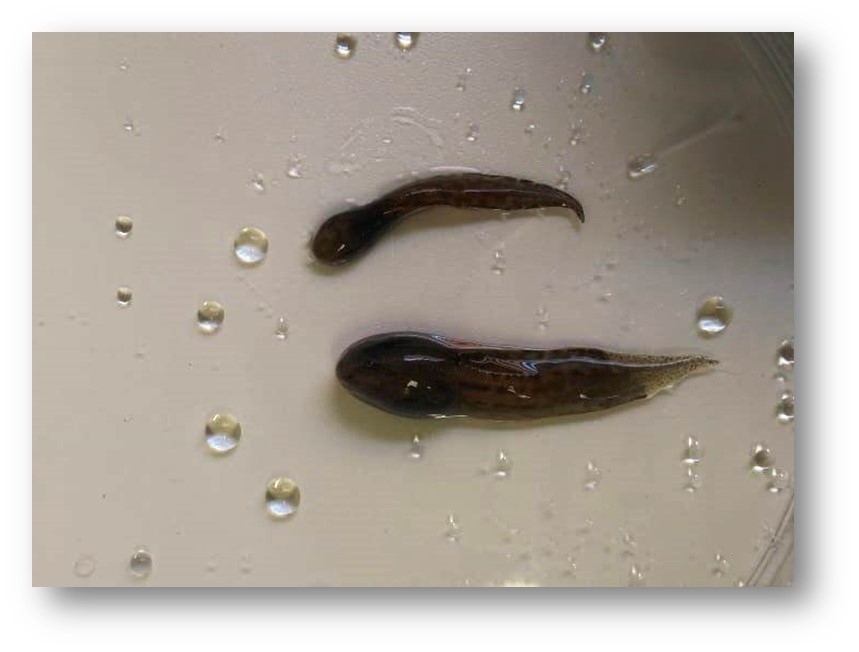


In the laboratory, tadpoles of the species B. ibitiguara kept in water 3 °C warmer than the highest temperature recorded in their habitat were unable to complete metamorphosis, indicating a threat to the species from climate change (differences in size and body mass between tadpoles acclimated at 18 °C and 25 °C/photos: Leonardo Longhini, UNESP)
Published on 06/27/2022
By André Julião | Agência FAPESP – In an article published in the journal Frontiers in Physiology, researchers show that tadpoles of Bokermannohyla ibitiguara, a stream-breeding savanna tree frog endemic to the Serra da Canastra region of Minas Gerais, Brazil, have a limited capacity to adjust to higher temperatures, making the species vulnerable to climate change and deforestation.
The researchers conducted laboratory tests in which they raised water temperatures above the average for the forest-lined streams inhabited by the species, and measured the tadpoles’ oxygen consumption and heart rate, among other physiological variables. They also verified whether the tadpoles swam, fed and metamorphosed to adulthood normally.
“The plasticity of the species is limited. Temperatures in the stream from which we collected specimens averaged 21.9 °C, with a high of 24.6 °C in the warmest months of the year and at a very specific time. We estimated that a rise of 3 °C will have a significant impact on the tadpoles, which cannot modulate their physiological variables sufficiently to adapt to such a change,” said Leonardo Longhini, first author of the article. The study was conducted while he was a master’s candidate at São Paulo State University’s School of Agricultural and Veterinarian Sciences (FCAV-UNESP) in Jaboticabal, Brazil, with FAPESP’s support.
A recent study by a different research group concluded that the topography of Serra da Canastra is the main factor determining the genetic diversity of the species, which is found only in the Cerrado, hence constituting one more reason for taking action to conserve this savanna-like biome (more at: agencia.fapesp.br/34667).
“The autonomic nervous system of these tadpoles is unable to compensate for the changes caused to their heart rate and metabolism by higher temperatures, and this affects their life cycle because they can’t complete metamorphosis,” said Luciane Gargaglioni, a professor at FCAV-UNESP supported by FAPESP and last author of the article. She led the study jointly with Lucas Zena, a postdoctoral research fellow at the University of São Paulo’s Institute of Biosciences (IB-USP).
Low plasticity
To arrive at these results, the researchers collected tadpoles in a rural area of Sacramento, a municipality in Minas Gerais. They left a temperature sensor at the site for just over a year to obtain an average temperature for control of the experiment. They developed non-invasive methods to measure oxygen consumption and heart rate in the tadpoles.
The tadpoles were first divided into two groups, one in an aquarium at 8 °C, the lowest temperature detected in the stream from which they were collected, and the other at 28 °C, three degrees above the highest temperature recorded in their habitat.
The second group displayed signs of reduced food intake, with lower body mass and failure to complete metamorphosis indicating limitations to the capacity to take up, process or assimilate sufficient nutrients to tolerate high metabolic rates at warmer temperatures.
The researchers next collected more specimens, but this time acclimated them at 18 °C and 25 °C, close to the highest temperature recorded in their habitat. Later they were subjected to a heating ramp, with temperatures rising steadily to 34 °C, when the death rate increased.
“The highest temperature they tolerated wasn’t different between the groups acclimated at 18 °C and 25 °C, showing that they aren’t very adaptable. If the gallery forest is cleared and temperatures rise, they won’t be able to improve their tolerance and survive the extra warmth,” Longhini said.
Heart rate also behaved similarly in both groups, even when metabolism measured by oxygen consumption increased at higher temperatures, showing that the heart did not keep pace with the new conditions.
“The Cerrado is highly susceptible to warming due to human land use, especially for pasture and crops. At the same time, its biodiversity is extremely rich, and it is even more endangered than the Amazon, with only 8% of its area protected. Studying an endemic species is a way of drawing attention to this,” Gargaglioni said.
The article “Thermal acclimation to the highest natural ambient temperature compromises physiological performance in tadpoles of a stream-breeding savanna tree frog” is at: www.frontiersin.org/articles/10.3389/fphys.2021.726440.
Source: https://agencia.fapesp.br/38993